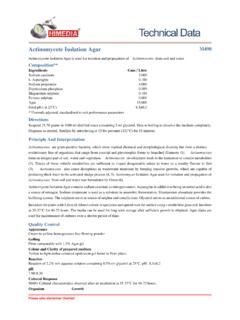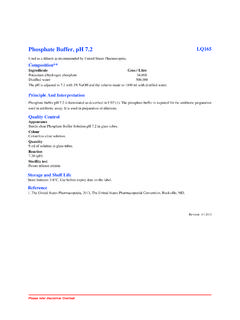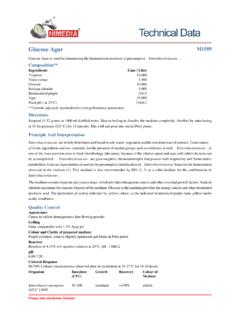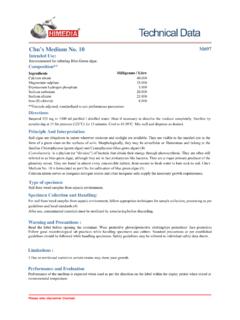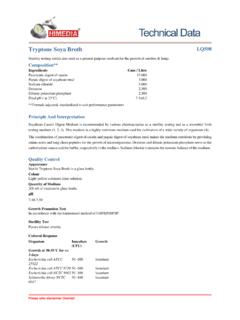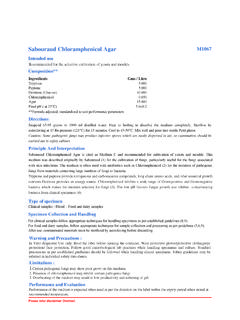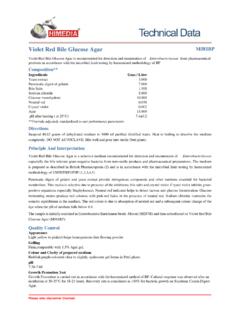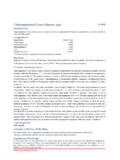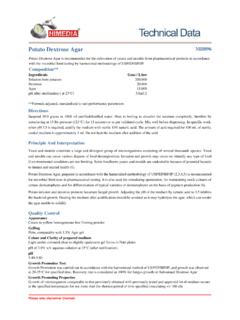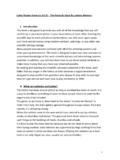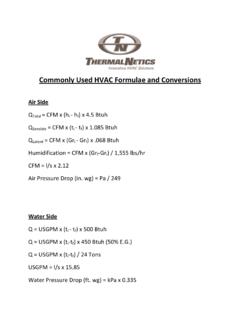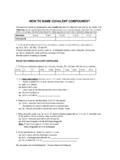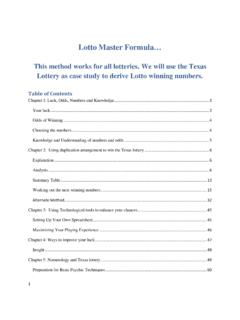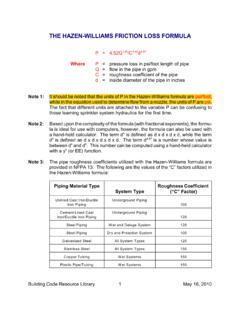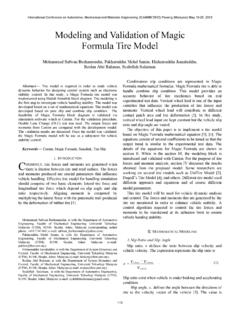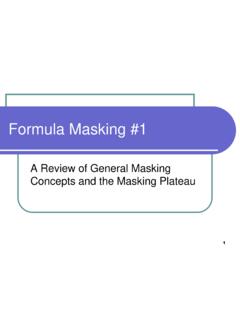Transcription of **Formula adjusted, standardized to suit …
1 Please refer disclaimer agar LESM1106M-Endo agar LES is used for enumeration of coliforms in water using a two step membrane filter **IngredientsGms / LitreCasein enzymic digest of animal lauryl pH ( at 25 C) ** formula adjusted, standardized to suit performance parametersDirectionsSuspend grams in 980 ml distilled water. Heat to boiling to dissolve the medium completely. DO NOT to 45 C and aseptically add 20 ml of 95% ethanol. Mix and dispense 4 ml amounts into 60 mm Petri plates. In largeplates, use sufficient medium to give a mm depth. DO NOT EXPOSE PLATES TO DIRECT : Basic fuchsin is a potential carcinogen and care must be taken to avoid inhalation and contamination of the And InterpretationIt is possible to remove bacteria from fluids by passing them through filters with such small pore size that bacteria are filtration technique enables fairly large volumes of water to pass rapidly under pressure, but prevents the passage of anybacteria present.
2 These nutrients are retained on the surface of the membrane which is then brought into contact with suitableliquid nutrients. These diffuse upwards through the pores thereby inducing the organisms to grow as surface colonies whichcan be counted (1).Endo Medium was first developed by Endo to differentiate between lactose-fermenters and non-fermenters (2). This mediumemployed sodium sulphite and basic fuchsin instead of bile salts to achieve inhibition of gram-positive bacteria (2). M-EndoAgar, LES is a modification of the original medium and is formulated as per McCarthy et al of Lawrence Experimental Station(LES) (3) for testing coliforms in water using a two-step membrane filter procedure, wherein Lauryl Sulphate Broth (M080)is used as the primary enrichment medium. This medium is recommended by APHA for testing coliforms in drinking and inbottled water (4, 5).
3 Presumptive coliform bacteria will form red colonies with metallic sheen after an incubation at 35-37 Cfor 24 enzymic hydrolysate, tryptose, peptic digest of animal tissue and yeast extract provide essential nutrients especiallynitrogenous for the coliforms. Lactose is the fermentable carbohydrate. Sodium sulphite, sodium deoxycholate and basic fuchsininhibit the growth of gram-positive organisms. Phosphates buffer the medium. Coliforms ferment lactose and the resultingacetaldehyde reacts with sodium sulphite and basic fuchsin to form red colonies and similar colouration of the medium. Lactosenon-fermenters form colourless the first step of enrichment, cotton absorbent pad is impregnated with Lauryl Sulphate Broth (M080). Membrane filterthrough which water sample is passed is aseptically placed on it and incubated without inverting for 2 hours at 35 C in a humidHiMedia LaboratoriesTechnical DataPlease refer disclaimer After incubation, the membrane filter is aseptically transferred to the M-Endo agar LES plate and incubated at35 C for 24 hours.
4 Alternatively membrane filter pad can be placed inside the lid of Petri plate of M-Endo agar LES and thenimpregnated with 2 ml Lauryl Sulphate Broth (M080) and incubated for 1 - 1 hours at 35 C. In the second step, the preparedmembrane filter is kept directly on the agar surface and incubated as described above. Presumptive coliforms produce goldengreen colonies with metallic sheen within 24 hours of density calculation : Note the coliform density in terms of total coliforms/100 ml. Extrapolate the count usingmembrane filters with 20-80 coliform colonies but not more than 200 of all types per formula for calculating the count is as follows:Total coliform colonies/100 ml =coliform colonies /ml of sample filtered x 100 Quality ControlAppearanceLight pink to purple homogeneous free flowing powderGellingFirm, comparable with agar gelColour and Clarity of prepared mediumRed coloured slightly opalescent gel forms in Petri platesReactionReaction of w/v aqueous solution with 2% v/v alcohol at 25 C.
5 PH : ResponseM1106: Cultural characteristics observed after an incubation at 35-37 C for 20 - 24 (CFU)GrowthColour ofcolony (onmembranefilter)Escherichia coli ATCC2592250-100good-luxuriantpink withmetallic sheenEnterobacter aerogenesATCC 1304850-100good-luxuriantpink to red(may havesheen)Salmonella Typhi ATCC653950-100luxuriantcolourless tovery light pinkStaphylococcus aureusATCC 25923>=10 inhibitedKlebsiella pneumoniaeATCC 1388350-100good-luxuriantpink to redSalmonella TyphimuriumATCC 1402850-100luxuriantcolourless tovery light pinkStorage and Shelf LifeStore below 30 C in tightly closed container and use freshly prepared medium. Use before expiry date on the R., Duguid J. P., Marmion B. P., Swain R. H. A., (Eds.), Medical Microbiology, 1975, 12th Ed. Vol. II, S., 1904, Zentralbl.
6 Bakteriol., Abt. 1, J. A., Delaney J. E. and Grasso R., 1961, Water and Sewage Works, 108 A. D., Clesceri L. S. and Greenberg A. W., (Eds.), 2005, Standard Methods for the Examination of Water andWastewater, 21st Ed., APHA, Washington, F. P. and Ito K., (Eds.), 2001, Compendium of Methods for the Microbiological Examination of Foods, 4th Ed.,American Public Health Association, Washington, LaboratoriesTechnical DataHiMedia Laboratories Pvt. Ltd. A-516,Swastik Disha Business Park,Via Vadhani Ind. Est., LBS Marg, Mumbai-400086, India. Customer care No.: 022-61471919 Email: : 2 / 2015 Disclaimer :User must ensure suitability of the product(s) in their application prior to use. Products conform solely to the information contained inthis and other related HiMedia publications.
7 The information contained in this publication is based on our research and developmentwork and is to the best of our knowledge true and accurate. HiMedia Laboratories Pvt Ltd reserves the right to make changes tospecifications and information related to the products at any time. Products are not intended for human or animal or therapeutic use butfor laboratory,diagnostic, research or further manufacturing use only, unless otherwise specified. Statements contained herein should notbe considered as a warranty of any kind, expressed or implied, and no liability is accepted for infringement of any patents.
